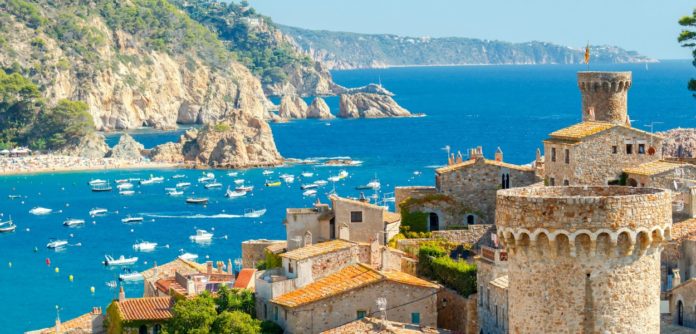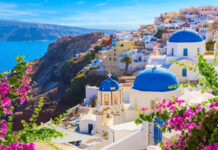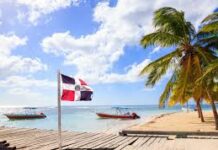Spain is a country on Europe’s Iberian Peninsula and is part of Southwestern Europe. It includes 17 autonomous regions having diverse geography and cultures. Its capital city Madrid is home to the Royal Palace and magnificent museums. The population of Spain is approx. 47.3 millions. Spain is the fifth most populous European Union member state; therefore, it uses the Euro as its main form of currency. Spain is a sovereign state that is almost completely surrounded by the Mediterranean Sea. To its northeast are France, Andorra and the Bay of Biscay, while to its northwest is Portugal. Spain has one official language and four other recognized languages. Its official language is Spanish; however Basque, Catalan, Galician, and Occitan are also spoken throughout various regions of Spain. The government in Spain is secular; therefore they do not recognize any official religion. However, Roman Catholicism is widely practiced. The Spanish flag is comprised of two horizontal red stripes surrounded by a wider yellow stripe. The Spanish coat of arms is printed on the yellow stripe of its flag.
Spanish cities such as Madrid and Barcelona are well connected by flights. Soccer is the national sport of Spain, but they call it Futbol. Real Madrid and Barcelona are most successful teams in Spain. Spain is one of the only eight countries ever to have won the FIFA World Cup, doing so in South Africa in 2010. It was the first time the team had reached the final. Bullfighting is another popular sport in Spain.
Some countries are full of character and man-made architectural wonders while others have nature on their side. Spain excels in each and every one of them, offering travelers a wealth of natural beauty, along with fascinating history, fabulous food, and a cultural scene that’s deep and authentic as well as creative and innovative. There are 44 World Heritage Sites in Spain that includes astonishing Roman ruins, gorgeously preserved old towns, and unique national parks replete with rare flora and fauna. The world’s oldest lighthouse is located in Spain. The Tower of Hercules was constructed in the 1st century and it still stands today. Originally, the Eiffel Tower was to be constructed in Spain, but, the city rejected the idea, and it was constructed for Paris.
Spain has a very high living expense. People who live in Spain often spend much money on their living expenses. Speaking about the facts of the Spanish culture, they have a festival called “La Tomatina”. It is basically a tomato fight festival and it has been celebrated once a year in the Valencian town of Bunol since 1945. It is generally celebrated on the last Wednesday of August every year. There exists an old tradition in Spain, in which Spaniards eats 12 grapes precisely when the clock chimes at midnight on New Year’s Eve.
Spain is much concerned about the Education and Health Care of its citizens. In Spain, education is free and compulsory for the children from the age of 6 to 16.
Health Care system in Spain is one of the world’s best health care systems as it is free for all legal citizens of Spain. The government of Spain spends 9.4% of its GDP in providing health care facilities. According to the data provided by the World Economic Forum in 2018, Spain ranks 4th in the list of countries with the highest life expectancy with the life expectancy of 83.4 years. According to a new study, it has been predicted that by 2040, Spain will dethrone Japan and will become the country having the longest life expectancy in the world.
After France and the United States of America, Spain is the third most visited country in the world with over 75 million visitors in 2017. There is an Island named The Pheasant Island which is situated between France and Spain. It belongs for 6 months to each country every year. It belongs to Spain from February to August and to France from August to February. It is the world’s oldest and smallest condominium. There are many semi-arid areas in Europe Continent, but Spain is the home of Europe’s only true-to-type, sand-and-rock desert, “Cabo de Gata” in Almería, Spain. Here annual rainfall is approx. 200 mm, the lowest in Europe. Seville Cathedral in Seville is the third-largest church and also the largest Gothic church in the world with an area of 23,500 square meters. Spain has the longest high-speed rail system in Europe and the second longest in the world, second to China with a maximum speed of 310 km/h (193 mph).
Spain is a really diverse country. It is like a bunch of different countries thrust together with really different languages, different cuisines, different cultures, different traditional drinks, and different climates. The north of Spain is called Green Spain. It has strong Celtic influences. It’s cooler and it rains a little bit more than other parts of Spain. Peoples in the northern parts of Spain usually drink cider, and play bagpipes. In the south, it changes dramatically. There are many palm trees in this area. There is a strong influence from the Moors who had invaded Spain in the 8th century.

Author Bio:- Laksh Garg, 14 years old student from Maur Mandi, Bathinda, Punjab

















